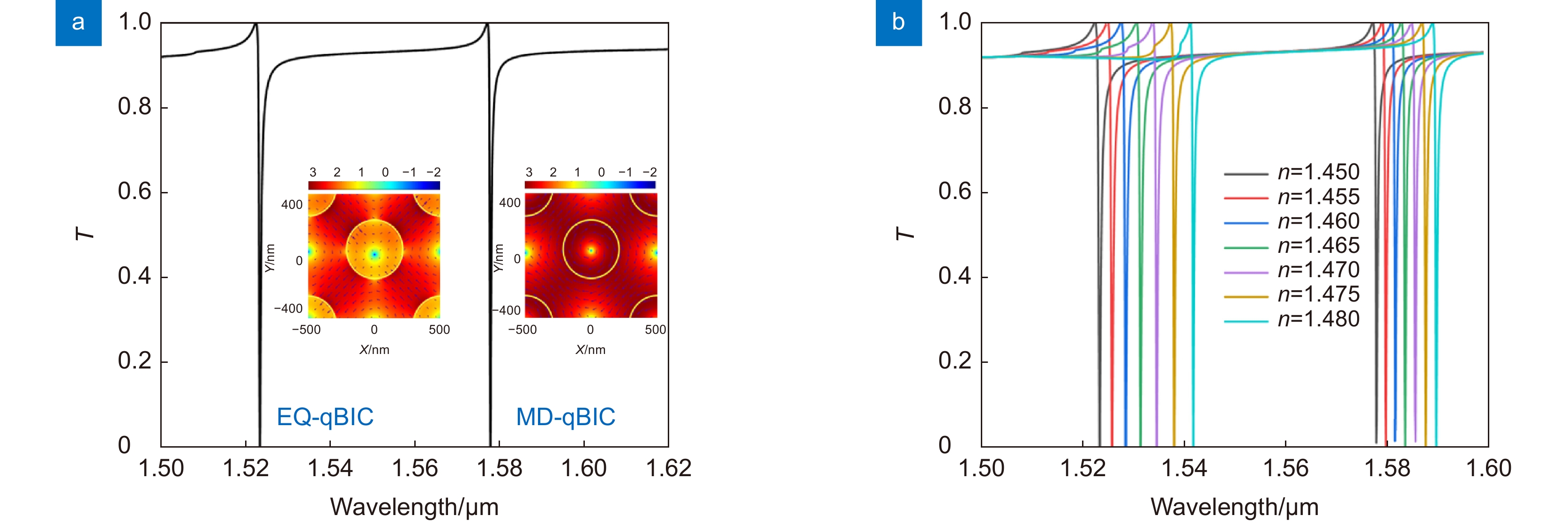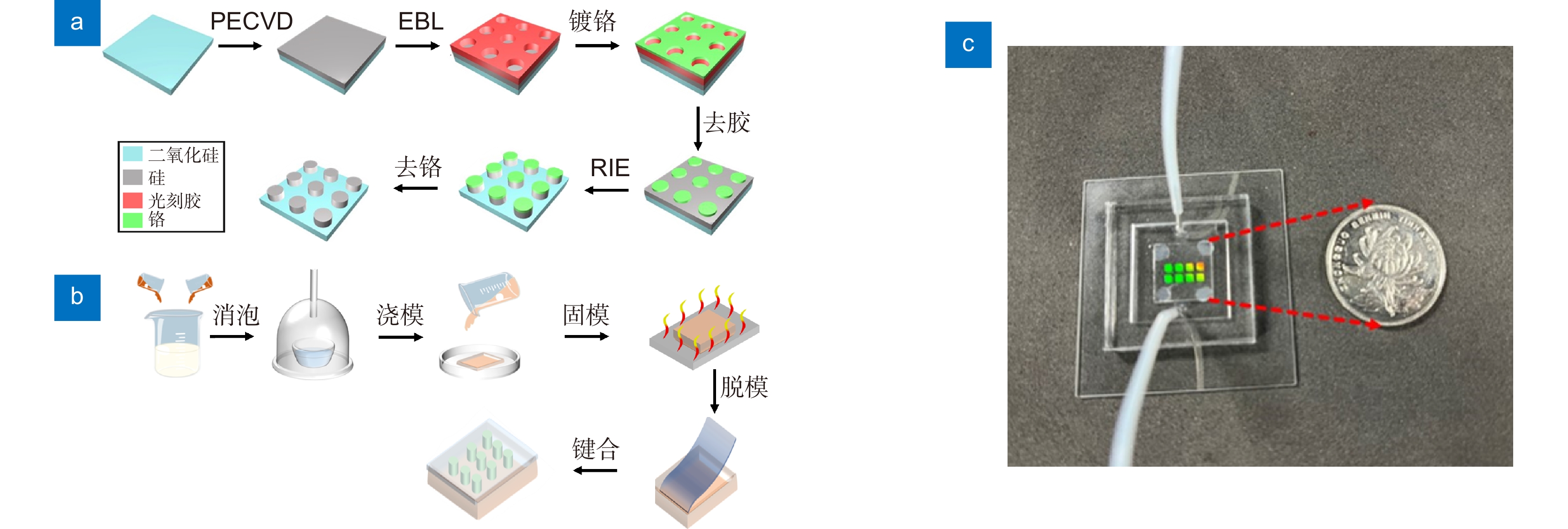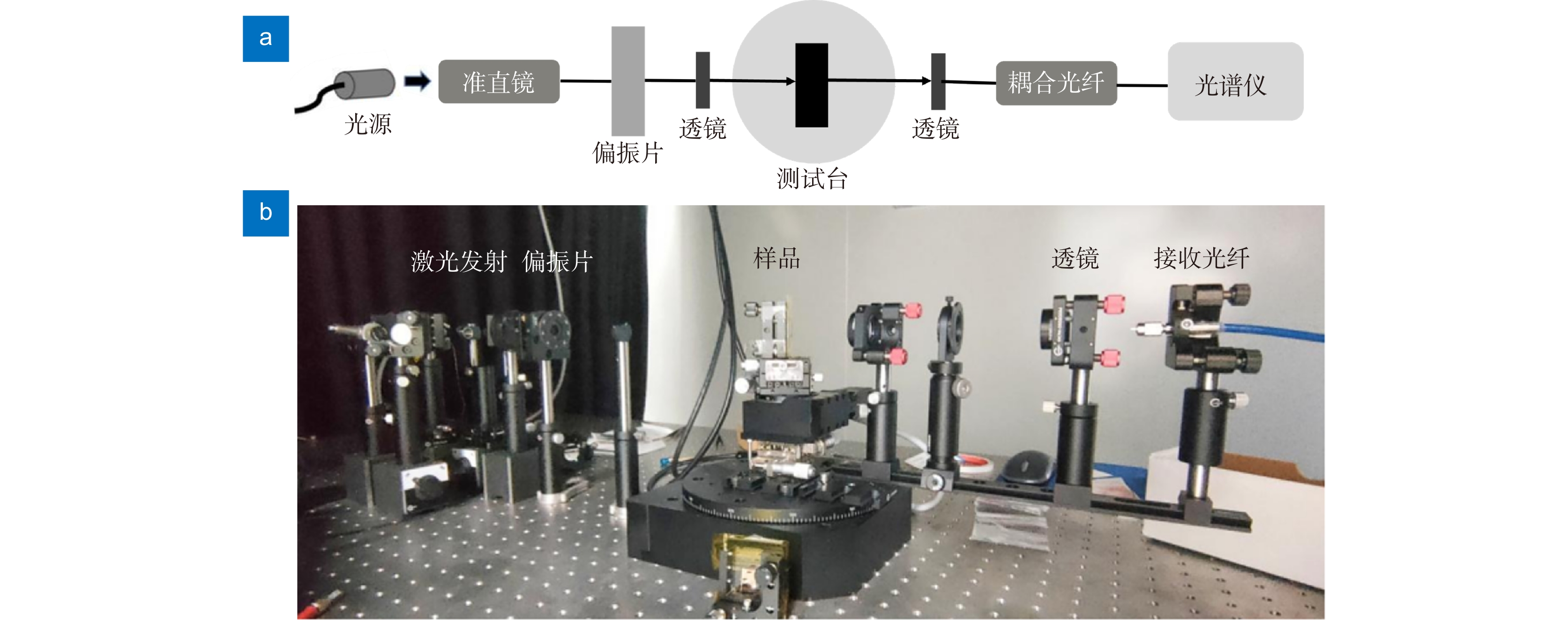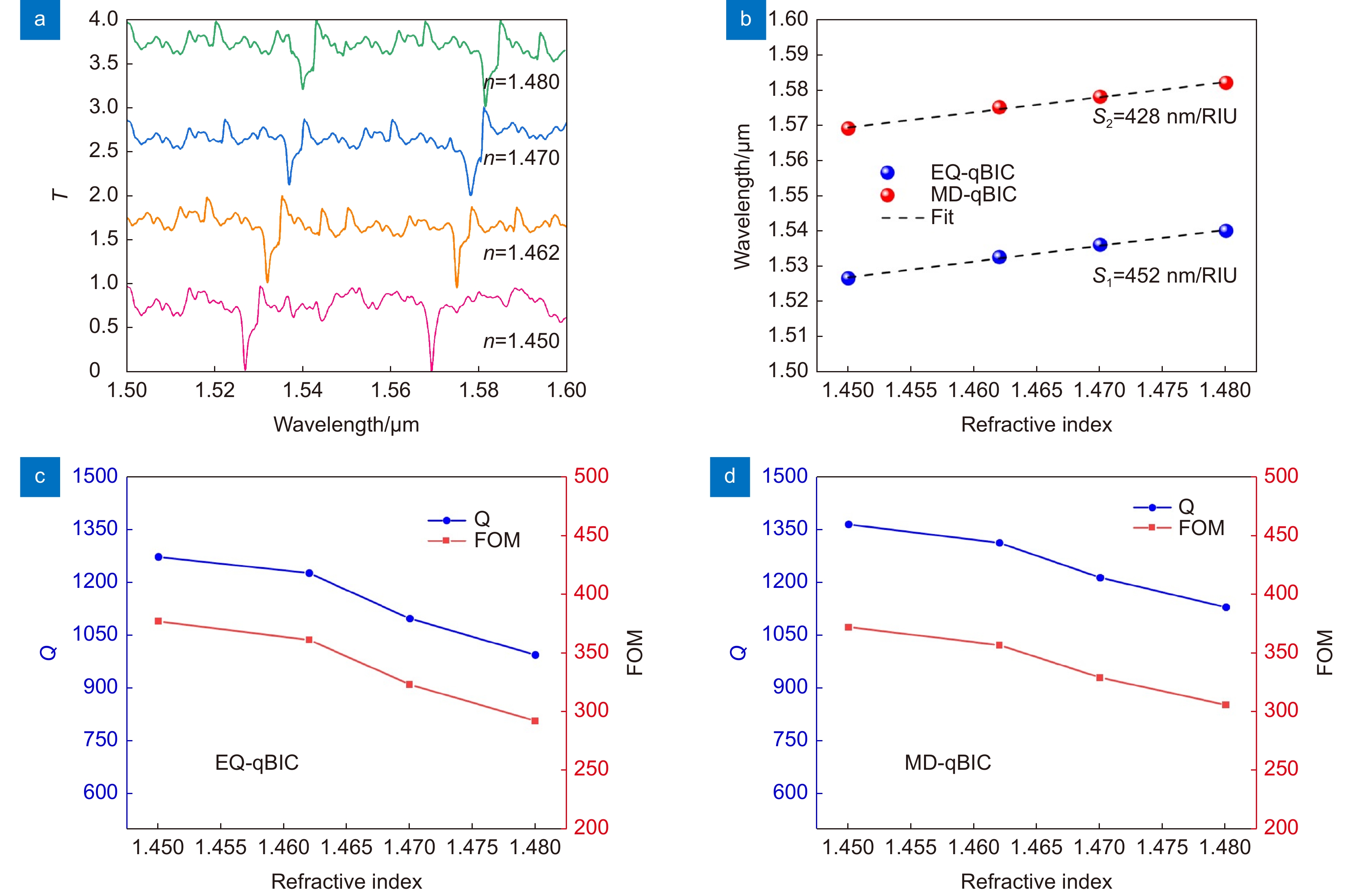Optofluidic refractometric sensor based on quasi-bound states in the continuum in all-dielectric metasurface
-
摘要
准连续域束缚态(Quasi-BIC)是超表面中一种特殊共振模,具有极高的品质因子,可以极大地提高光与物质的相互作用,在荧光增强、纳米激光、光传感以及非线性光学等领域均有重要应用。本文基于我们前期对quasi-BIC产生的理论,研究quasi-BIC介质超表面在折射率传感方面的应用。本文给出了传感系统的基本结构,利用电子束光刻技术结合注塑工艺完成了样品光流控结构的制备,并初步测试性能。研究结果表明,得益于产生quasi-BIC的新方法,该超表面具有两个高
Q 值quasi-BIC共振峰(1.523 µm和1.570 µm,品质因子分别为3069和4071)。以四种折射率溶液(n 分别为1.450/1.462/1.470/1.480)为样品的测试实验表明,两个共振峰均能完成折射率检测,灵敏度S分别为452 nm/RIU、428 nm/RIU,性能评价指标FOM分别为376.7、372,优于现有文献;共振波长和折射率之间线性度良好,展现了quasi-BIC超表面在折射率传感中的应用潜力。Abstract
The quasi-bound state in the continuum (quasi-BIC) is a special resonant mode in a metasurface with a very high quality factor that can greatly enhance the light-matter interaction and has important applications in fluorescence enhancement, nanolaser, optical sensing, and nonlinear optics. In this paper, we study the application of quasi-BIC dielectric metasurface for refractive index sensing based on the theory generated by our previous quasi-BIC. The basic structure of the sensing device is given, the preparation of the sample optofluidic structure is completed by using electron beam lithography combined with injection molding process, and the performance is initially tested. The results showed that the metasurface has two high-
Q quasi-BIC resonance peaks (1.523 µm and 1.570 µm, with quality factors of 3069 and 4071, respectively), thanks to the new strategy of quasi-BIC generation. The test experiments with four refractive index solutions (n =1.450/1.462/1.470/1.480, respectively) as samples showed that both resonance peaks could complete the refractive index detection with the sensitivity of 452 nm/RIU and 428 nm/RIU, respectively, and the performance evaluation indexes FOM were 376.7 and 372, respectively, which are better than the existing literature. The linearity between resonance wavelength and refractive index is good, showing the potential of quasi-BIC metasurface in refractive index sensing. -
Overview
Overview: The bound state in the continuum (BIC) is a special type of optical resonance state that lies in the continuum spectrum of the radiative state, yet remains perfectly localized due to symmetry protection and other topological protection. Since the BIC is completely uncoupled from spatial light, it is necessary in most applications to convert the symmetry-protected BIC and incidental BIC into a quasi-BIC (qBIC) with a high quality factor (Q-factor) by breaking the symmetry and adjusting the system parameters so that it can be excited by the external optical field and can radiate to the far field. The delocalized qBIC inherits the advantages of strong resonance of surface lattice resonance, low absorption loss, and great field enhancement over a large area outside the high refractive nanostructure. For sensing applications based on qBIC all-dielectric metasurfaces, the key performance parameters-sensing sensitivity and performance figure of merit (FOM)-can be effectively improved by high Q factor and great field enhancement in a large range of the object to be sensed. Therefore, we explored a sensor based on delocalized quasi-bound state in the continuum and designed an optofluidic sensor capable of detecting fluids with different refractive indices on an all-dielectric metasurface, which is encapsulated in an optofluidic chamber that provides a large interaction volume with the substance and can be fed with different liquids, gases, and other specific biomarkers through optofluidic channels for different samples delivery to the chip surface is greatly facilitated. By injecting liquids with different refractive indices into the optofluidic chamber of the dielectric metasurface, the device can be used as an optical refractive index sensor by monitoring the refractive index change caused by different liquids, and the structure has been experimentally achieved with a sensitivity of 452 nm/RIU and a FOM above 376.6, demonstrating a good refractive index sensing performance. The sensing performance of our sensor obtained in the experiment is superior to that of other sensors based on qBIC. The superior sensing performance is attributed to the significant field enhancement on the large volume outside the silicon nanopillar, as well as to the high quality factor. It is worth emphasizing that our sensor scheme offers advantages in material selection (transparency and miniaturization) and large sensing area, which is necessary in many cases in the field of biochemical sensing. The many advantages offered by the optofluidic sensors based on delocalized quasi-bound states in the continuum developed in this paper determine that the sensors we fabricated are very versatile and can operate in different spectral ranges. Moreover, the advantages of the optofluidic sensor designed in this paper can be applied to a variety of applications, such as biochemical reaction monitoring, photocatalysis, and trace molecule detection.
-

-
图 5 (a)不同折射率溶液的实验透射光谱图; (b)共振波长与折射率变化的线性拟合图; (c) EQ-qBIC的实验Q与FOM值; (d) MD-qBIC的实验Q与FOM值
Figure 5. (a) Experimental transmission spectra of different refractive index solutions; (b) Linear fit of resonance wavelength and refractive index variation; (c) Experimental Q and FOM values for EQ-qBIC; (d) Experimental Q and FOM values for MD-qBIC
表 1 不同折射率传感器性能的比较
Table 1. Comparison of the bulk RI sensing performance
References Structure Distinction Sensitivity/(nm/RIU) FOM [38] Asymmetric grooves Simulation 130 43.3 [39] Photonic crystal Simulation 148 821 [15] Photonic crystal Experiment 178 445 [40] Cubes Experiment 229.4 31.5 [41] Split-ring disk Experiment 282 4 [42] Nano block Simulation 306.7 10 [43] Double-gap split-ring Experiment 379 103 This work Nano disk arrays Experiment 452 376.7 -
参考文献
[1] Hsu C W, Zhen B, Stone A D, et al. Bound states in the continuum[J]. Nat Rev Mater, 2016, 1(9): 16048. doi: 10.1038/natrevmats.2016.48
[2] Fang C Z, Yang Q Y, Yuan Q C, et al. High-Q resonances governed by the quasi-bound states in the continuum in all-dielectric metasurfaces[J]. Opto-Electron Adv, 2021, 4(6): 200030. doi: 10.29026/oea.2021.200030
[3] Azzam S I, Kildishev A V. Photonic bound states in the continuum: From basics to application[J]. Adv Opt Mater, 2021, 9(1): 2001469. doi: 10.1002/ADOM.202001469
[4] Joseph S, Pandey S, Sarkar S, et al. Bound states in the continuum in resonant nanostructures: an overview of engineered materials for tailored applications[J]. Nanophotonics, 2021, 10(17): 4175−4207. doi: 10.1515/nanoph-2021-0387
[5] Koshelev K, Bogdanov A, Kivshar Y. Meta-optics and bound states in the continuum[J]. Sci Bull, 2019, 64(12): 793−796. doi: 10.1016/j.scib.2018.12.003
[6] Ha S T, Fu Y H, Emani N K, et al. Directional lasing in resonant semiconductor nanoantenna arrays[J]. Nat Nanotechnol, 2018, 13(11): 1042−1047. doi: 10.1038/s41565-018-0245-5
[7] Kodigala A, Lepetit T, Gu Q, et al. Lasing action from photonic bound states in continuum[J]. Nature, 2017, 541(7636): 196−199. doi: 10.1038/nature20799
[8] 戴建明, 张祎帆, 陈宇轩, 等. 液态水辐射源产生太赫兹波的研究进展[J]. 中国激光, 2021, 48(19): 1914003. doi: 10.3788/CJL202148.1914001
Dai J M, Zhang Y F, Chen Y X, et al. Research progress on Terahertz wave generation from liquid water[J]. Chin J Lasers, 2021, 48(19): 1914003. doi: 10.3788/CJL202148.1914001
[9] Xing H Y, Fan J X, Lu D, et al. Terahertz metamaterials for free-space and on-chip applications: From active metadevices to topological photonic crystals[J]. Adv Dev Instrumen, 2022, 2022: 9852503. doi: 10.34133/2022/9852503
[10] Carletti L, Koshelev K, De Angelis C, et al. Giant nonlinear response at the nanoscale driven by bound states in the continuum[J]. Phys Rev Lett, 2018, 121(3): 033903. doi: 10.1103/PhysRevLett.121.033903
[11] Liu Z J, Wang J Y, Chen B, et al. Giant enhancement of continuous wave second harmonic generation from Few-Layer GaSe coupled to high-Q quasi bound states in the continuum[J]. Nano Lett, 2021, 21(17): 7405−7410. doi: 10.1021/acs.nanolett.1c01975
[12] Liu Z J, Xu Y, Lin Y, et al. High-Q quasin bound states in the continuum for nonlinear metasurfaces[J]. Phys Rev Lett, 2019, 123(25): 253901. doi: 10.1103/PhysRevLett.123.253901
[13] Chen Y, Du W, Zhang Q, et al. Multidimensional nanoscopic chiroptics[J]. Nat Rev Phys, 2022, 4(2): 113−124. doi: 10.1038/s42254-021-00391-6
[14] Luo Y, Chi C, Jiang M J, et al. Plasmonic chiral nanostructures: Chiroptical effects and applications[J]. Adv Opt Mater, 2017, 5(16): 1700040. doi: 10.1002/adom.201700040
[15] Romano S, Zito G, Torino S, et al. Label-free sensing of ultralow-weight molecules with all-dielectric metasurfaces supporting bound states in the continuum[J]. Photonics Res, 2018, 6(7): 726−734. doi: 10.1364/PRJ.6.000726
[16] Yesilkoy F, Arvelo E R, Jahani Y, et al. Ultrasensitive hyperspectral imaging and biodetection enabled by dielectric metasurfaces[J]. Nat Photonics, 2019, 13(6): 390−396. doi: 10.1038/s41566-019-0394-6
[17] Leal-Junior A, Avellar L, Biazi V, et al. Multifunctional flexible optical waveguide sensor: on the bioinspiration for ultrasensitive sensors development[J]. Opto-Electron Adv, 2022, 5(10): 210098. doi: 10.29026/oea.2022.210098
[18] Maksimov D N, Gerasimov V S, Romano S, et al. Refractive index sensing with optical bound states in the continuum[J]. Opt Express, 2020, 28(26): 38907−38916. doi: 10.1364/OE.411749
[19] Huo Y Y, Zhang X, Yan M, et al. Highly-sensitive sensor based on toroidal dipole governed by bound state in the continuumin dielectric non-coaxial core-shell cylinder[J]. Opt Express, 2022, 30(11): 19030−19041. doi: 10.1364/OE.456362
[20] Hsu C W, Zhen B, Lee J, et al. Observation of trapped light within the radiation continuum[J]. Nature, 2013, 499(7457): 188−191. doi: 10.1038/nature12289
[21] 王鹏飞, 贺风艳, 刘建军, 等. 基于连续谱束缚态的高Q太赫兹全介质超表面[J]. 激光技术, 2022, 46(5): 630−635. doi: 10.7510/jgjs.issn.1001-3806.2022.05.008
Wang P F, He F Y, Liu J J, et al. High-Q terahertz all-dielectric metasurface based on bound states in the continuum[J]. Laser Technol, 2022, 46(5): 630−635. doi: 10.7510/jgjs.issn.1001-3806.2022.05.008
[22] Hong P L, Xu L, Rahmani M. Dual bound states in the continuum enhanced second harmonic generation with transition metal dichalcogenides monolayer[J]. Opto-Electron Adv, 2022, 5(7): 200097. doi: 10.29026/oea.2022.200097
[23] Koshelev K, Lepeshov S, Liu M K, et al. Asymmetric metasurfaces with high-Q resonances governed by bound states in the continuum[J]. Phys Rev Lett, 2018, 121(19): 193903. doi: 10.1103/PhysRevLett.121.193903
[24] Fan J X, Li Z L, Xue Z Q, et al. Hybrid bound states in the continuum in terahertz metasurfaces[J]. Opto-Electronic Sci, 2023, 2(4): 230006. doi: 10.29026/oes.2023.230006
[25] Du X, Shi J, Li G Y, et al. Dual-band bound states in the continum based on hybridization of surface laatice resonces[J]. Nanophotonics, 2022, 11(21): 4843−4853. doi: 10.1515/nanoph-2022-0427
[26] Rodrigo D, Tittl A, Ait-Bouziad N, et al. Resolving molecule-specific information in dynamic lipid membrane processes with multi-resonant infrared metasurfaces[J]. Nat Commun, 2018, 9(1): 2160. doi: 10.1038/s41467-018-04594-x
[27] Diaz-Diestra D, Thapa B, Beltran-Huarac J, et al. L-cysteine capped ZnS: Mn quantum dots for room-temperature detection of dopamine with high sensitivity and selectivity[J]. Biosens Bioelectron, 2017, 87: 693−700. doi: 10.1016/j.bios.2016.09.022
[28] Liu G S, Xiong X, Shi H Q, et al. Photonic cavity enhanced high-performance surface plasmon resonance biosensor[J]. Photon Res, 2020, 8(4): 448−456. doi: 10.1364/PRJ.382567
[29] 王向贤, 陈函文, 朱剑凯, 等. 金纳米锥阵列与金薄膜耦合结构表面等离子体折射率传感研究[J]. 光电工程, 2022, 49(12): 220135. doi: 10.12086/oee.2022.220135
Wang X X, Chen H W, Zhu J K, et al. Research on surface plasmon refractive index sensing of gold nano cone array andgold film coupling structure[J]. Opto-Electron Eng, 2022, 49(12): 220135. doi: 10.12086/oee.2022.220135
[30] Zhang Y N, Zhao Y, Lv R Q. A review for optical sensors based on photonic crystal cavities[J]. Sensors Actuat A Phys, 2015, 233: 374−389. doi: 10.1016/j.sna.2015.07.025
[31] Baaske M D, Vollmer F. Optical observation of single atomic ions interacting with plasmonic nanorods in aqueous solution[J]. Nat Photon, 2016, 10(11): 733−739. doi: 10.1038/nphoton.2016.177
[32] Xu X Y, Chen W J, Zhao G M, et al. Wireless whispering-gallery-mode sensor for thermal sensing and aerial mapping[J]. Light Sci Appl, 2018, 7(1): 62. doi: 10.1038/s41377-018-0063-4
[33] David A, Benisty H, Weisbuch C. Fast factorization rule and plane-wave expansion method for two-dimensional photonic crystals with arbitrary hole-shape[J]. Phys Rev B, 2006, 73(7): 075107. doi: 10.1103/PhysRevB.73.075107
[34] Bin-Alam M S, Reshef O, Mamchur Y, et al. Ultra-high-Q resonances in plasmonic metasurfaces[J]. Nat Commun, 2021, 12(1): 974. doi: 10.1038/s41467-021-21196-2
[35] Liu B W, Chen S, Zhang J C, et al. A plasmonic sensor array with ultrahigh figures of merit and resonance linewidths down to 3 nm[J]. Adv Mater, 2018, 30(12): 1706031. doi: 10.1002/adma.201706031
[36] Yang A K, Hoang T B, Dridi M, et al. Real-time tunable lasing from plasmonic nanocavity arrays[J]. Nat Commun, 2015, 6(1): 6939. doi: 10.1038/ncomms7939
[37] Baur S, Sanders S, Manjavacas A. Hybridization of lattice resonances[J]. ACS Nano, 2018, 12(2): 1618−1629. doi: 10.1021/acsnano.7b08206
[38] Modi K S, Kaur J, Singh S P, et al. All-dielectric complementary-asymmetric-arcs metasurface based refractive index sensor[C]//Frontiers in Optics 2019, Washington, 2019: JW4A. 125.https://doi.org/10.1364/FIO.2019.JW4A.125.
[39] Wang Z, Xue Q, Zhao S L, et al. Study on the characteristics of a photonic crystal sensor with rectangular lattice based on bound states in the continuum[J]. J Phys D Appl Phys, 2022, 55(17): 175106. doi: 10.1088/1361-6463/ac4c59
[40] Campione S, Liu S, Basilio L I, et al. Broken symmetry dielectric resonators for high quality factor Fano metasurfaces[J]. ACS Photonics, 2016, 3(12): 2362−2367. doi: 10.1021/acsphotonics.6b00556
[41] Zhang Q, Wen X L, Li G Y, et al. Multiple magnetic mode-based Fano resonance in split-ring resonator/disk nanocavities[J]. ACS Nano, 2013, 7(12): 11071−11078. doi: 10.1021/nn4047716
[42] Hu J, Lang T T, Shi G H. Simultaneous measurement of refractive index and temperature based on all-dielectric metasurface[J]. Opt Express, 2017, 25(13): 15241−15251. doi: 10.1364/OE.25.015241
[43] Yang Y M, Kravchenko I I, Briggs D P, et al. All-dielectric metasurface analogue of electromagnetically induced transparency[J]. Nat Commun, 2014, 5(1): 5753. doi: 10.1038/ncomms6753
-
访问统计


 E-mail Alert
E-mail Alert RSS
RSS

 下载:
下载:








